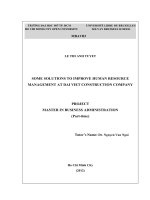Case study 6 strategic human resource management AT MERTON HEALTHCARE TRUST
Bạn đang xem bản rút gọn của tài liệu. Xem và tải ngay bản đầy đủ của tài liệu tại đây (80.88 KB, 6 trang )
Case Study 6. Strategic Human Resource Management AT
MERTON HEALTHCARE TRUST
The case
The Merton Healthcare Trust manages one of the leading provincial teaching hospitals. As
explained by the Chief Executive, the critical success factors for the Trust are ‘to deliver our
contracts and this means meeting our volume and quality requirements and staying within
budget’. On the achievements of the Trust, the Chief Executive commented:
If you want to ask if we are successful, the answer is yes. We deliver our contracts,
we’re in excess by about 4 or 5 per cent a year, a rising target; we do so within budget
and get a Charter Mark. If you do want to measure things, the measured success is
there, but if you ask me if I am satisfied, of course I’m not. We can always do better.
Corporate and strategic HR planning within the NHS is substantially different from that in
other organizations. This is because of the nature of the NHS as it has developed. The Chief
Executive’s trenchant comment on its management approach was:
I think people try and impose an out-of-date, industrial-style management structure on
the Health Service which is wholly inappropriate. A lot of what is being attempted will
fail. How damaging this will be it is difficult to say, because one of the characteristics of
the Health Service is that no matter how badly you manage it you can’t stop people
treating patients. If the Health Service manufactured Fiestas it would have gone
bankrupt years ago, but it doesn’t; it manages management while the health carers get
on with caring for patients.
Corporate strategy
On corporate strategy the Chief Executive said:
It’s a misunderstanding that we can have a strategy. I don’t believe it. We have to have
a flexible response mechanism. If we have any long-term strategy at all, it is that of
flexibility.
People talk about a finance-led strategy. But you can’t have a finance-led strategy
because it’s only a measurement. What you have to have is a commitment to provide
the best possible care within the resources available and the people best able to do that
are at operational level, not at management level, not at board level and certainly not at
regional level.
The approach to formulating strategy in the Trust clearly depended on the management style
of the Chief Executive. His following remarks convey some indication of this:
I’ve only got two lines in my job description: if anything goes wrong it’s my fault; if
anything goes well, it’s to somebody else’s credit because I didn’t do it. I think that’s the
only job description a chief executive should have.
It’s a sort of battle all the time, isn’t it, and I redress the balance, and nobody knows
that I haven’t really got any power at all.
(On performance-related pay) I refuse to pay the workforce 97.5 per cent for failing
and 2.5 per cent for succeeding. It’s an insult and all it does is demotivate people. I pay
them 100 per cent for succeeding and it’s my job to make sure they succeed. It’s not my
job to dock their pay if they don’t. So we have a success-oriented strategy in which we
expect people to succeed and if they don’t, we help them to succeed.
The Finance Director gave his own impression of how strategies are formulated in the Trust:
Our corporate strategies are evolved over a period of time through discussions between
the executive directors and the Trust board. In a sense our strategies are evolved
through our management style. We have a visionary Chief Executive, a Medical
Director who has a very cool head and knows how everything works, a Director of
Operations who is a real go-getter and a driver, a Director of HR who is a thinker and I,
who am very task-oriented. And out of this we get our strategies.
The importance of the team approach was underlined by the Director of Operations:
Our strategy has to be very flexible. We put it together by debate amongst executive
members of the board. This has all the hallmarks of people who have worked together
for a long time, and trust one another, and don’t take offence.
HR strategy
The Director of HR commented that:
We have to be an organization which can do whatever the purchasers require. So our
corporate strategy has to be about preparedness, flexibility, attitude and reputation. So
it’s very much an HR strategy.
The Director of Operations said that:
My contribution to the HR strategy is to keep on asking the question: ‘What sort of
person will we need to deliver the care in five, eight and ten years’ time?’
The task
What insight can be gained from the approach to corporate and HR strategy in this NHS
Trust in the light of the following observations and views on strategy? In particular, where
does the Merton Trust strategy formulation process fit in the fourfold typology suggested by
Whittington?
Observations and views
It has been said (Bower, 1982) that 'strategy is everything not well defined or understood'.
This may be going too far, but in reality, strategy formulation can best be described as
'problem solving in unstructured situations' (Digman, 1990) and strategies will always be
formed under conditions of partial ignorance.
The difficulty is that strategies are often based on the questionable assumption that the
future will resemble the past. Some years ago, Robert Heller (1972) had a go at the cult of longrange planning: 'What goes wrong', he wrote, 'is that sensible anticipation gets converted into
foolish numbers: and their validity always hinges on large loose assumptions.'
More recently, Faulkner and Johnson (1992) have said of long-term planning that it:
was inclined to take a definitive view of the future, and to extrapolate trend lines for the
key business variables in order to arrive at this view. Economic turbulence was
insufficiently considered, and the reality that much strategy is formulated and
implemented in the act of managing the enterprise was ignored. Precise forecasts
ending with derived financials were constructed, the only weakness of which was that
the future almost invariably turned out differently.
Strategy formulation is not necessarily a rational and continuous process, as was pointed out
by Mintzberg (1987). He believes that, rather than being consciously and systematically
developed, strategy reorientation happens in what he calls brief 'quantum loops'. A strategy,
according to Mintzberg, can be deliberate – it can realize the intentions of senior
management, for example to attack and conquer a new market, but this is not always the
case. In theory, he says, strategy is a systematic process: first we think, then we act; we
formulate then we implement. But we also 'act in order to think'. In practice, 'a realized
strategy can emerge in response to an evolving situation' and the strategic planner is often 'a
pattern organizer, a learner if you like, who manages a process in which strategies and
visions can emerge as well as be deliberately conceived'.
Mintzberg was even more scathing about the weaknesses of strategic planning in his 1994
article in the Harvard Business Review on 'The rise and fall of strategic planning'. He contends
that 'the failure of systematic planning is the failure of systems to do better than, or nearly as
well as, human beings'. He went on to say that:
Far from providing strategies, planning could not proceed without their prior existence…
real strategists get their hands dirty digging for ideas, and real strategies are built from
the nuggets they discover… sometimes strategies must be left as broad visions, not
precisely articulated, to adapt to a changing environment.
Other writers have joined in this chorus of disapproval, for example:
Business strategy, far from being a straightforward, rational phenomenon, is in fact
interpreted by managers according to their own frame of reference, their particular
motivations and information (Pettigrew and Whipp, 1991).
Although excellent for some purposes, the formal planning approach emphasizes
'measurable quantitative forces' at the expense of the 'qualitative, organizational and
power-behavioural factors that so often determine strategic success'… Large
organizations typically construct their strategies with processes which are 'fragmented,
evolutionary, and largely intuitive'. Quinn (1980)
The most effective decision makers are usually creative, intuitive people 'employing an
adaptive, flexible process'. Moreover, since most strategic decisions are event-driven
rather than pre-programmed, they are unplanned. Digman (1990)
Goold and Campbell (1986) also emphasize the variety and ambiguity of influences that
shape strategy:
Informed understandings work alongside more formal processes and analyses. The
headquarters agenda becomes entwined with the business unit agenda, and both are
interpreted in the light of personal interests. The sequence of events from decision to
action can often be reversed, so that ‘decisions’ get made retrospectively to justify
actions that have already taken place.
Mintzberg (1978, 1987, 1994) summarizes the non-deterministic view of strategy admirably.
He perceives strategy as a 'pattern in a stream of activities' and highlights the importance of
the interactive process between key players. He has emphasized the concept of 'emergent
strategies', and a key aspect of this process is the production of something that is new to the
organization even if this is not developed as logically as the traditional corporate planners
believed to be appropriate.
Kay (1999) also refers to the evolutionary nature of strategy. He comments that there is
often little ‘intentionality’ in firms and that it was frequently the market rather than the visionary
executive which chose the strategic match that was most effective. Quinn (1980) has produced
the concept of ‘logical incrementalism’ that suggests that strategy evolves in several steps
rather than being conceived as a whole.
A fourfold typology of strategy has been produced by Whittington (1993):
1. Classical – strategy formulation as a rational process of deliberate calculation. The
process of strategy formulation is seen as being separate from the process of
implementation.
2. Evolutionary – strategy formulation as an evolutionary process, which is a product of
market forces in which the most efficient and productive organizations win through.
3. Processual – strategy formulation as an incremental process that evolves through
discussion and disagreement. It may be impossible to specify what the strategy is
until after the event.
4. Systemic – strategy is shaped by the social system in which it is embedded. Choices
are constrained by the cultural and institutional interests of a broader society rather
than the limitations of those attempting to formulate corporate strategy.
Comment
This case study can be used to explore the nature of strategy in relation to its context, which
includes the type of activity and people in the organization, the degree of turbulence in the
environment and, as is evident in this case, the personalities of those involved, especially
the Chief Executive. For HR specialists the case can be used to emphasize the contingent
nature of HR strategy, the pressure for flexibility (typical in many if not all organizations, not
just NHS Trusts) and the need to be sensitive to the environment and the people involved. A
strategic approach is not just about following a number of well-established rules.
References
Bower, J L (1982) Business policy in the 1980s, Academy of Management Review, 7 (4), pp
630–38
Digman, L A (1990) Strategic Management – Concepts, decisions, cases, Irwin, Georgetown,
Ontario
Faulkner, D and Johnson, G (1992) The Challenge of Strategic Management, Kogan Page,
London
Goold, M and Campbell, A (1986) Strategies and Styles: The role of the centre in managing
diversified corporations, Blackwell, Oxford
Heller, R (1972) The Naked Manager, Barrie & Jenkins, London
Kay, J (1999) Strategy and the illusions of grand designs, Mastering Strategy, Financial
Times, pp 2–4
Mintzberg, H (1978) Patterns in strategy formation, Management Science, May, pp 934–48
Mintzberg, H (1987) Crafting strategy, Harvard Business Review, July–August, pp 66–74
Mintzberg, H (1994) The rise and fall of strategic planning, Harvard Business Review, January–
February, pp 107–14
Pettigrew, A and Whipp, R (1991) Managing Change for Strategic Success, Blackwell, Oxford
Quinn, J B (1980) Strategies for Change: Logical incrementalism, Irwin, Georgetown, Ontario
Whittington, R (1993) What is Strategy and Does it Matter?, Routledge, London









